Grease Penetration Test Methods in Use!
August 19, 2022
Greases are composite materials made from base oils of varying viscosity and various thickeners. Different batches of grease have different soap levels and compositions. The main purpose of grease testing is to ensure product quality and to plan the market for new products. Penetration testing is considered the most important laboratory test item. ASTM test methods can detect the consistency of grease. If stale grease is used as a sample, then a large sample size is required. Therefore, this method is not suitable for the grease being used. Now, alternatives to penetration testing have emerged. For example, you can feel the softness and hardness of grease by touch. However, these alternatives are rudimentary, unable to obtain accurate data, and unable to predict the changing trend of grease. Instruments such as controlled stress rheometers can not only meet the above requirements, but are also suitable for testing fresh or in-use grease.
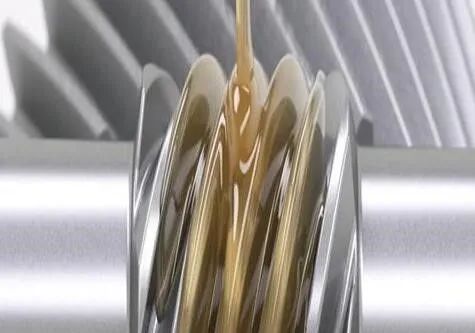
Penetration test questions Penetration test refers to letting the vertebral body sink into a certain amount of grease within a specified time, and the depth of the vertebral body sinking into the grease is an indicator to measure the consistency of the grease. The American Lubricating Grease Institute (NLGI) uses penetration to classify grease consistency numbers. There are three ratios of cone and cup sizes in this test, the largest being a full-size cone with a fat cup of about 290 ml, and the smallest a 1/4 scale cone with a 3.8 ml cup. The capacity of the grease worker grease cup determines the amount of grease required for the test. Specimens obtained in practical applications are usually insufficient for a penetration test. In fact, few devices have more than 290 ml of grease in the oil sump, which is the minimum number of specimens required for full-scale cone testing. Even though the amount of grease required for the 1/4 scale cone test is 3.8 ml, it is only a small pool of oil that can be collected. This test is not suitable for greases that are in use or whose quality is to be tested, as the collected grease is often not sufficient for a penetration test. Penetration test is divided into working penetration test and non-working penetration test. More accurate results can be obtained by preprocessing grease samples. The samples for the working penetration test require 60 reciprocations beforehand. This pretreatment is for fresh grease only. Grease samples in use do not need to be pre-conditioned before testing and can be tested directly by starting the machine. Penetration testing methods are too crude, and test results are misleading. NLGI's consistency grading is linear, like 0, 1, 2, 3... and so on. However, in fact, the change curve of the consistency of grease is non-linear. In a linear arrangement, NLGI grade 4 greases should be twice as thick as NLGI grade 2 and four times as thick as NLGI grade 1. However, it is not. Figure 1 shows that as the penetration of the grease increases, the surface area of the cone-grease interface also changes. Cone penetration is shown in the figure for easy comparison. As shown in the figure, the curve of the surface area change of the contact surface between the cone and the grease is non-linear with the increase of the degree of penetration.
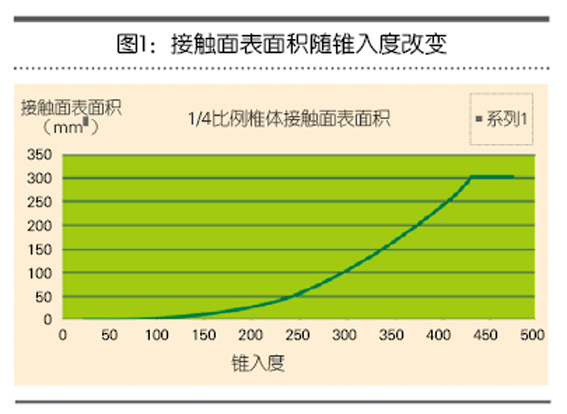
Using the NLGI consistency classification method is conducive to the diversification of product types, and the greater the consistency, the more types of grease products. Under the same NLGI grade, producers can produce products with different rheological properties, resulting in huge manufacturing margins. However, using the NLGI method to classify the consistency of greases can also introduce errors. If the stress of the grease (unit: Pascals) is used to represent the consistency of the grease, the error of the NLGI classification method will be very large. All greases within a certain penetration range can be considered NLGI grade 2. For greases of the same NLGI grade 2, the product with the highest penetration is 175% less stressed. As shown in Table 1, the stress difference between NLGI grade 4 and NLGI grade 3 greases is exactly equal to the stress difference between an NLGI grade 2 grease with intermediate penetration and an NLGI grade 00 grease with the lowest penetration. This kind of error is like a small trap, and people get confused if they don't know the nonlinear nature of the NLGI taxonomy.
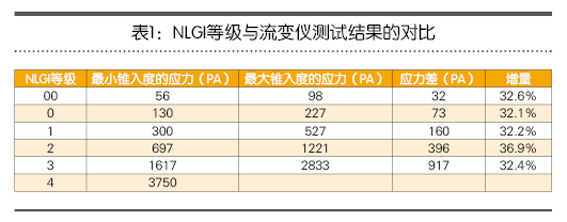
Use of a rheometer A rheometer is an instrument that detects the physical properties of grease under constant or varying external force, temperature, and oscillating shear amplitude. Rheometers are gradually coming to the fore among devices in various industries. Compared to the penetration test, the sample volume required by the rheometer is as low as 0.25 to 0.4 ml. Rheometers are not commonly used in the grease industry to test grease samples. People are new to rheometer testing. But it can test the shear stress of the grease as an indication of consistency, and the test results are error-free. The yield stress test can come in handy when comparing the results of a rheometer test with a penetration test. The shear stress applied in the yield stress test keeps growing. A stress value is obtained at regular intervals. When testing, if the material is elastically deforming, the stress curve is nearly vertical; if the material is flowing, the curve is gradually horizontal. The Y value corresponding to the turning point of the curve from vertical to horizontal is the yield stress. Yield stress refers to the stress that occurs when the grease begins to flow after the elastic deformation reaches the limit under certain test conditions. Temperature has a huge impact on yield stress testing, so controlling temperature is critical. Installing a heat sink on the instrument can solve this problem. Some rheological tests take hours or even days. These lengthy tests can yield accurate results. However, these tests are not applicable for most greases being tested in service. An ideal product test should be accurate and time-consuming. A series of tests such as stress sweep and frequency sweep were carried out according to the general test sequence, and finally the yield stress test was carried out to obtain the results shown in Figure 2. Grease properties can be measured through a series of tests prior to yield stress testing. The manner in which the grease samples are preconditioned is determined by the test sequence. The initial sample was placed on a flat plate with a radius of 25 mm, and the distance between the plates was set to 1 mm. The grease is then cut to ensure that the edges of the specimen are even and the specimen is undamaged. After completing a test, the equipment software automatically lowers the machine head to ensure that the sample is in contact with the upper and lower clamps and the sample is undamaged. The edge of the specimen does not need to be trimmed between the completion of the previous test and the start of the next test. The head drop distance setting remains the same for each sample. Rest up to 1 minute between tests. Multiple sets of tests in different sequences ensured that all grease samples received similar testing and preconditioning practices. The frequency sweep test required a consistent preprocessing method, and the processing time was close to 7 minutes, while the overall test time was only slightly longer than 7 minutes. The yield stress rheometer test takes less than 1 minute. Test data analysis Fifty-four fresh and in-use samples were examined using the quarter-scale cone test and the yield stress rheometer test. These samples include 6 kinds of fresh greases including polyurea grease, lithium complex grease, calcium complex grease, clay refined Calcium Sulfonate base grease, as well as clay thickened grease, calcium complex thickened grease, etc. Grease in use. The NLGI consistency grades of the two samples are already known, which facilitates our determination of the penetration. The exact materials of these samples are unknown. These grease samples were considered unworked. After taking the sample from the grease block, it is only preconditioned and then placed in the grease cup. We cannot determine how well the samples obtained in practical applications work. The vertebral body was dropped into the sample three times, and the average of the test results was recorded. The test is performed at room temperature in the laboratory, typically 22°C to 24°C. Figure 3 clearly shows the nonlinear nature of the NLGI consistency grade based on the data output by the rheometer. Figure 2 shows the results and connections for the two test methods. Table 1 shows stress data for various NLGI grades of grease. Note that the thicker the grease, the greater the consistency error in its consistency grade.

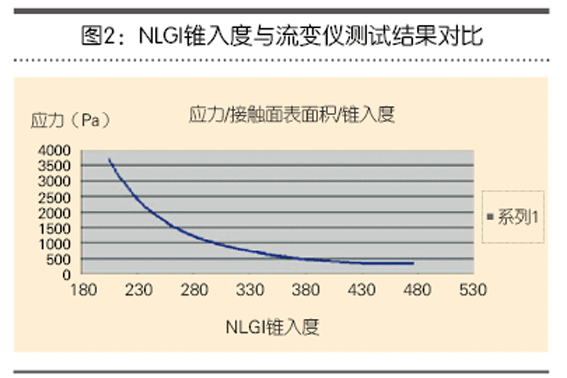
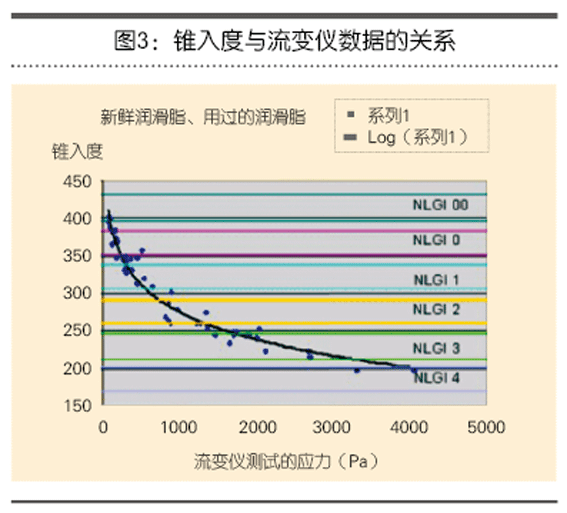
In order to determine the number of repetitions of the instrument and test sequence, the test requires 3 greases, with multiple tests for each grease. The same grease is contained in a container. Types of greases tested included lithium 12 hydroxystearate greases, calcium sulfonate greases, clay thickened greases, and more. The test results are shown in Table 2.

Clay-thickened greases and lithium-based thickened greases had a deviation of nearly 15%, while calcium sulfonate-based greases had deviations of nearly 5%. The number of times the instrument will be reused is not stated. Grease in use requires more testing than fresh grease from the same batch. Figure 2 shows the nonlinear nature of NLGI grades. Data for greases above NLGI grade 4 remains unknown due to the inability to collect grease samples above NLGI grade 4.












